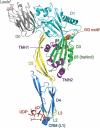Cholesterol-dependent cytolysins: from water-soluble state to membrane pore
- PMID: 30117093
- PMCID: PMC6233344
- DOI: 10.1007/s12551-018-0448-x
Cholesterol-dependent cytolysins: from water-soluble state to membrane pore
Abstract
The cholesterol-dependent cytolysins (CDCs) are a family of bacterial toxins that are important virulence factors for a number of pathogenic Gram-positive bacterial species. CDCs are secreted as soluble, stable monomeric proteins that bind specifically to cholesterol-rich cell membranes, where they assemble into well-defined ring-shaped complexes of around 40 monomers. The complex then undergoes a concerted structural change, driving a large pore through the membrane, potentially lysing the target cell. Understanding the details of this process as the protein transitions from a discrete monomer to a complex, membrane-spanning protein machine is an ongoing challenge. While many of the details have been revealed, there are still questions that remain unanswered. In this review, we present an overview of some of the key features of the structure and function of the CDCs, including the structure of the secreted monomers, the process of interaction with target membranes, and the transition from bound monomers to complete pores. Future directions in CDC research and the potential of CDCs as research tools will also be discussed.
Keywords: Cholesterol-binding protein; Cholesterol-dependent cytolysin; Membrane-protein interactions; Pore-forming toxin.
Conflict of interest statement
Conflict of interest
M.P. Christie declares that she has no conflict of interest. B.A. Johnstone declares that she has no conflict of interest. R.K. Tweten declares that he has no conflict of interest. M.W. Parker declares that he has no conflict of interest. C.J. Morton declares that he has no conflict of interest.
Ethical approval
This article does not contain any studies with human participants or animals performed by any of the authors.
Figures



References
Publication types
Grants and funding
LinkOut - more resources
Full Text Sources
Other Literature Sources

